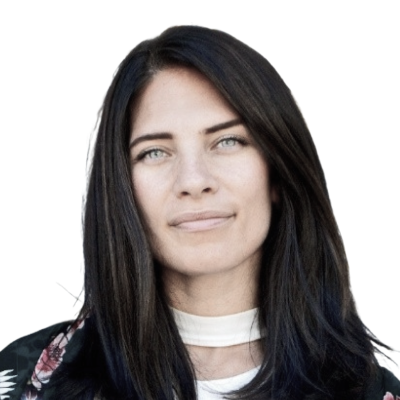

Megan Murphy
VP of Product at Hotjar
How to Build a Product Team That Delivers
“Humble Decisiveness” is the most important quality of a product manager – Megan Murphy, VP of Product at Hotjar
We spoke with Megan Murphy, VP of Product at Hotjar, to find out how they’re growing one of the most successful user research products in the world and how their fully remote team is serving over 700,000 businesses. Megan comes with a wealth of experience in product management, having worked at companies like Skyscanner and N26, so her deep product thinking is nothing short of inspiring.
In this episode:
– How is the product team at Hotjar structured and how they operate
– How to build a remote corporate culture beyond the posters on the wall (it starts with hiring!)
– How they use user personas and Jobs to be Done at Hotjar
– How to balance optimisation and experimentation to make sure you’re delivering towards the business objectives
– What are the red flags that a product is heading for trouble?
– Some interesting findings from experiments Megan ran at Hotjar and Skyscanner
– What are the most important qualities of a good product manager?
Check out the rest of the episodes!
Transcript
Please note this transcript is automated
FULL TRANSCRIPT:
00:01 Desi The best place to learn about product management and growth is from the people who have done it over and over again. I spoke with Megan Murphy, VP of product at Hotjar, to find out how they are growing one of the most successful products in the user research space and how their fully remote team is serving over 700,000 businesses across the world. Megan comes with a wealth of experience in product management, having worked at companies like N26 and Skyscanner. So here is what she’s got to share.
00:50 Desi Hello, Megan!
00:51 Megan Murphy Hi! Thanks for having me!
00:54 Desi Welcome to The Product Show!. It’s a pleasure to have you here. And thank you for agreeing to spend some time with us. Right, we’ve got so much to talk about so let’s start with your experience and your journey so far and how did you end up at Hotjar?
01:06 Megan Murphy Sure. So the TLDR of my journey is that I got into product by accident and it was a very happy accident because in my previous lives, I worked on WallStreet and as a technical project manager. I didn’t really find my fit in those roles, so when I got into product and I was just kind of pushed into it by the startup, that somebody had to go and build something, and that somebody was me and I felt like I finally I found my fit, at that point I was living in San Francisco, had a nutrition startup back then. And fast forward a couple years and a couple countries and a couple companies later and my background is largely in B2C,. I kind of cut my teeth at the first sort of product and scaled role that I had at SkyScanner, where I grew our car hire and transportation team and business quite significantly, from a team of about 3 people to over 30 people by the time that I left. I worked in N26, leading product, I was the first Head of Product there for monetization and finance products. But I found myself at Hotjar a year ago because it was the first time where I ever felt like I really needed to go somewhere that aligned with my values and the way that I want to work. And be the kind of leader that I always wanted to be, but I never really had to follow. And so yeah, I’ve been there for a year and in the VP of Product role, at Hotjar I lead our Product, Design and Data teams. So we’re a company and we have 700,000 businesses using Hotjar across most of the globe. And our team is in 30 countries so it’s been a crazy year, my first week was actually first week of lockdown, within the company. It’s a hell of a time to get started in a new role. But it’s been really cool so far to see investing culture and trying to bring a complete transformation to the product itself, it’s been really fun so far.
03:07 Desi Yeah, that sounds like an amazing journey so far. Let’s talk a little bit more about Hotjar, you mentioned values. Can you give us an example what you mean here, especially when it comes to product growth and management?
03:21 Megan Murphy Sure! So I think at least in my experience, most companies that talk about leading with their values it’s limited to posters on the walls and you know, public image and PR. At Hotjar, we take it really seriously so for example, we have 5 core values. And every person at hotjar can name those 5 core values off the top of their head. The reason for this is because it comes out in the work that we do every day and we’re all held accountable for those values. So every person at hotjar, when we go through our performance reviews, which are twice per year, we’re actually rated in terms of how much we live our core values. So one of our values is building transparency. So in a performance review cycle, your colleagues will be asked to give examples of instances in which you did or didn’t build trust with your colleagues or customers or team. Through transparency and you know, being direct. Another one of our core values is for people to move fast. And so when we’re in every day meeting, no matter the context, should we launch this, should we release this, should we do this interview, should we you know, anytime we’re confronted with a decision, you hear people say what’s the bolder option?. How can we move quickly? So I think I’ve seen a culture where people just recognize that the way that they lead needs to be consistent with our values, it’s a very special thing and going through the interview process at Hotjar, candidates are also held to this standard. So we’ll evaluate candidates on whether or not they’re a good fit for Hotjar based on did they obsess over their work, did they build trust with their transparency, were they bold? Did they learn by doing? Which means they’re not afraid to make mistakes. So I think that just this culture, if you really, really take it seriously, it comes out in how you interview and recruit, how you decide to hire, how you approach performance reviews, how you make decisions every day, and no matter how many posters are on our proverbial wall, there’s nothing that replaces recruiting people who really want to live by those values in the first place.
05:35 Desi What do you think is the most important qualities of a good product manager? And what are you looking for when you’re hiring product managers for your team?
05:45 Megan Murphy I would say that one of the most important qualities is someone who is decisive, but not arrogant about their decisiveness, so I don’t want to work with anybody a product manager or whatever their roles is, who are decisive to a fault of not allowing new information to change their decisions, right? So I want somebody who has conviction and confidence in making decisions, but who isn’t afraid to change their opinion and go like oh, I didn’t know that before. And now this changes things, let me reconsider. Okay, I agree with you. Let’s change direction. So with product managers, I look for humble decisiveness as the first thing and the second thing there’s so much modern discourse in the product community these days about the need to have like simultaneous discovery and delivery and I completely hold myself to that standard and I agree with that. I think the best product managers are ones who recognize that they really need to balance both of those. So you need to stay with the eyes ahead of the curve and looking at where the ball is rolling, where’s the market going, what are customers expecting and anticipating, so you need to discover that. But you don’t need to like, you can’t let it sit there, you can’t discover and discover and do nothing and let your findings sit in a corner and collect dust, you need to act on them and that means delivering. So I think that taking this seriously and recognizing that there’s a balance is very important, product managers who don’t deliver are just strategists. And product managers who only deliver and don’t discover new things, I guess optimize stuff and manage projects. So I’m really looking for people who could live both of those and who don’t see it as a competition, they just see like that’s the gig, the gig is to find problems and solve them, rinse and repeat over and over again.
07:35 Desi Yeah, very interesting. I think one of the biggest sins really, especially in user research is okay, you can spend weeks or even months learning about your users, but what you do with the information after that? Right? And how do you actually use it to improve the product? And it’s down to the personal qualities, but sometimes it’s about the process and how the company has organised, how it operates internally. Can you tell me a bit more about how the product team at Hotjar and how you operate.
08:07 Megan Murphy Sure! So within product at Hotjar, we organized a number of modern tech companies In this Tribes and Squads model by Spotify, which I saw at SkyScanner when I worked there as well. So at Hotjar, underneath the product umbrella of products, you have Experience Design, which is a number of design disciplines, including user research, you have product management and then you have out data disciplines as well, Data engineering, data analysts and data scientists as well. In terms of the vertical and horizontal mix, so we have a number of tribes and I’m pretty open about this, I think structures are something that a product leader should talk more about, because it’s hard everywhere and it’s constantly evolving. So at Hotjar, we’ve got a tribe called Grow and Monetize for example. And in that tribe sit a number of squads that help us grow our business and monetize our product. So you’ll find there for example a Pricing and Packaging team, an Acquisition team, a Payments team, so how do we generate revenue and capture it and grow our customer base in partnership of course, with our marketing and sales team. Each squad is more or less made up of 2 or 3 frontend and backend engineers and then a team lead, which is what most companies call tech lead, at Hotjar. And a product designer and a product manager, so it’s a pretty good representation of a number of disciplines. We have other roles, as I mentioned, within product which include research and our data disciplines, they’re not embedded within the squads per se, but they support a number of squads each, so I think in more mature companies, I’ve seen this embedded model where you have your data analyst, data scientist, your growth folks, your marketing folks etc., all aligned in every single squad. I think it’s just a matter of scale, at hot-jar, we have a team today of 150 people and so that kind of setup is a bit beyond our own size right now, but I certainly see the day where that is a reality at Hotjar.
10:19 Desi Amazing stuff! Hotjar is certainly a product that helps other product understand their users better and improve the user experience. So I believe we all can learn a little bit from what you guys are doing there. So can you tell me how you’re using user personas, for example and is your approach to personas different to what is standard for the market?
10:41 Megan Murphy Sure. So the way that we’re using personas at Hotjar is largely a reflection of two things. What I’ve seen elsewhere that I thought worked and didn’t work and also the contributions of a number of folks in our team so actually going through a change right now where we’re shedding the style of personas that we used to have and moving toward a new model. And that work encompasses folks from brand, marketing, product, research so the transformation of our personas is a multi faceted initiative together, because all of us use personas differently, so the way that a sales team would benefit from having strong personas is different from someone in support, which is different from someone in design. So what I saw in other companies are basically two polar opposites, in one place, I saw personas based on the really quantitative profiles of usage so it was talking about frequency of doing some action, intensity of using specific features, it was very quantitative and had no emotional story, no nothing. And the next place, I saw the complete opposite, where there was basically no behavioural data or ethnographic data, it was just like a story and pictures and so what I’m trying to do at Hotjar is encourage our team together to create personas that are useful for all of our work on a daily basis to make better quality decisions faster. That’s the whole point. So right now, what we’re changing from, in the past, is we had a number of personas that were basically a 1:1 match with the job title. So there was a persona called digital market, another one called product manager. What we’re doing now is actually looking at let’s level up from jobs to be done and think about what different roles have in common according to what they need to do. For example, one of our new personas may be something like, they’re not set in stone yet, but it might be something like the storyteller, it doesn’t matter if it’s a product manager, product marketer or researcher, whatever. What matters is that the needs of that persona are to tell a story and synthesise presumably a bunch of inputs into a couple of outputs that makes sense to get them out, to tell a narrative that lands And so we’re framing our personas less around job titles and more around the storyteller, the investigator. Maybe even the investigator is an analyst or researcher, it doesn’t matter if they come from either part of the spectrum. They are the ones digging in and trying to understand things further. So this approach I am very optimistic will help get balance between what I saw in other places where there was like over-inducting on either qualitative or quantitative. And like I said, I’m most helpful that the personas really bring our customers and their needs to life in a way that can be actioned every single day by a number of different disciplines, within Hotjar.
13:52 Desi I like that you mentioned the Jobs to be Done theory. We use it when building products for our clients. Can you give me a couple of examples perhaps of how you’re using it at Hotjar?
14:06 Megan Murphy Sure! So when I think about Jobs-to-be done, one thing that really matters to me is that we don’t think of jobs so specifically that we pursue local suboptimizations in every part of the product. So at hotjar, we have a recordings product and we have a surveys product for example, among others. And I think that it’s important to consider what does somebody want to see, what one of our users wants to see when they’re watching a recording?. Okay, they want to see if someone gets angry and frustrated, they wanted to see when someone successfully finishes something in the flow, like they checkout or whatever it may be. Separately, if they’re looking at a survey, one of our users wants to see did somebody complete a survey? How did they feel about this?. Which questions really spoke to them? But if we focus so specifically on the job of the survey and the job of the recording, the action is the big picture which is how was this person’s experience with that product and what do they have to say about it? And so I think it’s important with jobs to be done to recognize your altitude, when you fly low, you have to care about in the moment, in the context, but when you zoom out at a higher altitude you have to recognize that ultimately the job to be done, no matter your business or your customer, is to make your customer a hero, right? You want them to be a hero in whatever it is that they want to do and pursue. And so I think for us, using that framework, when a user wants to make a survey or analyze the responses of a survey and when they want to watch a recording and extract some insights from it, we have to make sure we don’t lose sight of it, because the buck doesn’t stop there, you have to zoom out and say how does someone want to understand what is going on in their product and then see what people say about it and how can we make this one very smooth connected experience and make it super easy to parse? So I’m not saying we are the best example of this today, but I can promise we will be soon.
16:08 Desi Can you give me an example of a small UX improvement or a UX tweak that you’ve done at Hotjar or some of the other companies that you’ve worked before that had a disproportionately high impact on the product, something small that turned into a big win.
16:26 Megan Murphy Sure! Yeah, I’ll share one recently from Hotjar, so we recently launched a Slack integration, it was towards the end of last, and I’ll speak as a customer, this is how I speak every day so as a Hotjar user, I use Hotjar and I also use Slack within my company and whenever I receive my company collects some feedback from our users, we want to see it and not let it go unlistened to because the voice of the customer matters so much, so actually what we did at Hotjar was we launched a new integration with Slack such that anytime a customer leaves feedback or you have a new reporting come in, you can receive this in a Slack channel setup for this where you can choose where they’re rooted to in your Slack channels. And the results of this have been pretty astonishing so far, I wouldn’t say that this is an improvement per se, it’s just a really small like lateral move into some new space, thinking about what are the use cases of our customers, what are their jobs to be done? Their jobs to be done is to listen to the voice of the customer, make sure they can hear it and then take action. And so this Slack integration, we’ve seen a healthy uplift in retention, in the frequency of use and a number of users per account added because when some folks see “hey this user just left feedback”, that’s a really nice loop for us to attract new users within the same account. So I would say that’s one good example. Specifically about the experience, in terms of an improvement, my mind goes to something that I worked on at SkyScanner, which was when you’re travelling and you choose your travel dates, you notice that a lot of travellers, this is pre-COVID, I know this sounds like ancient history, a lot of travellers once upon a time used to choose their travel dates based on public holidays. So okay there’s a 3 day weekend, but if I take off 2 days at work, I can go away for 5 days. Right? And so we used to an API from a holidays calendar an open source API out there and we built that into our product such that as a user based in the UK, when I go to choose dates, it showed me on the calendar which dates were public holidays. That way I wouldn’t have to Google when the holidays are this year, right? So we did this for the top 10 markets by volume of flight search for SkyScanner and we saw some really nice results there and this is something that I built while I was there and we actually went on to build on top of this further and further with some marketing campaigns, and some nice landing pages, so just a small tweak of show on a Friday that this is a holiday and you’ll get people to say okay, this is more realistic, I don’t have to jump from my SkyScanner tab to go look up the holiday schedule and then come back, cause you know every time someone leaves your product, they go somewhere else to do research, the chance that they actually return to finish the job to be done sinks, right? So this had a positive impact.
19:37 Desi Yeah, it’s very interesting. Sometimes the best product improvements come from quite a lot of research and sometimes it’s purely by accident or just trying something you were discovering, I never imagined that this would have this huge impact. This goes back to the topic that I’m really passionate about, how do we build a culture for experimentation? And how do we make sure that people feel free to go and explore and break things, and learn from their mistakes? Without being accused of not delivering towards the business objective or wasting their time perhaps. Do you think this is a luxury for bigger companies or is this something that younger companies can adopt and what’s your experience with that?. Positive and negative.
20:24 Megan Murphy Sure. Yeah, so I think that in my experience, typically the bigger the company, the more there is a trap of optimization instead of innovation.. There’s very few that can really balance this well. I mean, I think Netflix is a great example, I use that just to set the tone of what I’m saying so instead of just thinking about DVD’s and then streaming content, now they’re thinking about content production, so I love that they recognized that what they’re up against is not exclusively other streaming services, they’re up against a bottle of wine and sleep. And I think that if you really, really continue asking why why why why your product matters and you can recognize what your competition is, which is really just how other people spend their time not necessarily the next best thing in the market, this is the attitude that I like to take in my work, so in terms of giving people the freedom to experiment and to learn and to adapt and fail, I fully believe in this. However, I think that you know, a lot of companies assume that what works good for Google or any of the other tech companies is good for them, right? You see this play out in job descriptions, people just rip off job descriptions from big tech companies without thinking critically about their bias baked in to the way requirements were written? The same thing happens with experimentation, a lot of smaller companies think they need to experiment because that’s what the best in class tech companies are doing, but what they don’t recognize is that there is time consumption and brain space consumption baked into A/B or multivariate tests. And I fully support and I’ve had some really nice wins with experimentation in my experiences as an individual contributor so it feels great when you can say this X percent jump is the consequence of our work together. That’s very powerful, but it’s not always needed, because what’s needed is confidence to take a decision. And how do you get confidence to take a decision? You have the answers that people are gonna expect you to answer. And how you will have those?. You have to assess your risk. So actually I think in terms of the way that we approach innovation and optimization comes down to your risk appetite, is the risk, if we want to launch a new feature. Is the risk of this feature the customer value, would they get value from it ok great! Is the risk about usability?. Okay, there’s high risk cause it’s hard to use, but the value’s high so that means that’s an opportunity to experiment and to iterate on the experience we know they get value from it, now let’s reduce the risk that usability sacrifices that value. Right? So I think that if you look at opportunities, whether they’re innovation or optimization through a risk lens, then you can better understand when to flex your muscles on A/B tests and quantitative experiments and when customer validation through qualitative discovery will suffice. I don’t think one size fits all, this is how the greats have managed to continue innovating, they know when to optimize because they’ve captured the market attention on something, they’ve proven the value, the business viability, they proven out that the experience works whereas you also have to take some swings on something new in order to stay relevant and that’s where you can’t A/B test your way to innovation. So you have to have a safe space to fail. I think that leadership sets the tone for failure being an accepted part of the culture ideally, you don’t just make the same mistakes, you only make them once.
24:04 Desi Right yeah. Very interesting. I agree with the point, even when it comes to UX and design, sometimes you will have people with expectations that you need to spend months on discovering something that’s already been discovered and there’re best usability principles that you can follow and build on them, rather than discover everything from scratch. Can you give me maybe an example or what’s your view on, what are the red flags that a product is heading for trouble?
24:42 Megan Murphy Sure! So I think one of the most important indicators is customer feedback hitting a certain Inflection point so when people get value from your product, the feedback that they give you, let’s say “wohoo, we love this!” That’s positive stuff. If it’s not a screaming I love you, it’s about giving them more, so hey, have you ever thought of an integration with bla bla? Have you ever thought about making it easier to… This is so great, it would be even better if you would… If your feedback on customer sounds like this, I think that’s a very healthy indicator, but if you hit this inflection point where that becomes less prevalent than this is broken, this doesn’t work, this looks old, this is behind, I’m switching to another product, this is too expensive for the value that I’m getting now. If that feedback is coming not from the majority of your customers, but of the customers you want but of the majority of the customers that you want to serve, this is dangerous, this is a point that the people you seek to serve and whose problems you think you’re solving, if there’s more of the complaints rather than the requests, this is a very clear indicator that you’re off and that you really got to change. So I think that that balance is very important to me, that’s a really important indicator. And so at Hotjar, out tools are inherently about bringing the voice of your customers to your ears, right? So every other Wednesday, I have lunch with the product and design team and have an open invitation to whoever wants to join and in that lunch discussion, because hotjar is generous enough to give us a work together budget that we can use remotely so we can all order lunch together for example. So we sit there and order our lunch and then we read through customer feedback from the previous 2 weeks and we start with the angriest. And then we have a Miro board where we track the whole journey, so every single piece of feedback that comes in from a customer, we build our own user journey based on the feedback that comes in, which is mostly, we start with the most negative, because with positive feedback, we’re grateful, we love our customers and we’re so happy that they’re happy, but we know that that’s not the area to improve, just like in a performance review, you’re like happy and feel fulfilled and gratified with the positive feedback, but it’s really the negative one that shows you where to go, right? So it’s the same thing with a product as it is with the personal development, it’s like what are people telling you they want more of, what are they telling you you’re not meeting their expectations and then how can you keep track of this and take action and not just let it accumulate over time?
27:26 Desi Right. So as the VP of Product of such a successful company and with your previous experience, you have achieved a lot in product management. Who do you learn from? How do you make sure that you keep on top of things and you always can deliver the best results for your team and the companies you work for?
27:50 Megan Murphy Sure. So I am not shy about talking about the support system that I have built or I actively build, so I have 2 mentors, I pursued that kind of relationship when I said “hey, when I worked with you, I really valued what you did X, Y, Z and usually the people I look up to are the ones who make hard decisions,. I think that’s inherent leadership. If a leader can’t make a hard decision, then I don’t know what they’re leading. So I’m attracted to leaders who can make hard decisions with grace, who can make people understand and bring them along for the journey and so I have two mentors I’m really lucky that both of them are CEOs of pretty big companies, I just have a million things to learn from them and I’m humbled that they would even work with me, honestly. I also have a coach that I work with, which is on my own management style, I recently went through storytelling coaching as well, I had a storytelling coach from a cool startup called PlotWolf. They coached our whole product team in terms of how to tell great stories and how to build the structure of the story and make a story with beets, with a punchline. So yeah, and then in my personal life, I have a therapist, so I’m growing from advice and the guidance and sometimes just someone who listens and makes me feel heard and expressed and not judged, whether it’s my personal or professional life, there’s so many people I look up to and I just, it took me a while to get comfortable raising my hand and saying I have no idea what I’m doing, it looks like you do, are you willing to show me the way? Right? And then I can form my own opinions based on if I think some of these approaches feel natural for me because I also don’t want in the midst of working with so many people that I admire, I don’t want to lose myself either so I need to make sure I stay true to who I am and use the language that feels natural to me, because I’m not trying to become anybody else, I’m just trying to take from other what I think is working from them and learn how to give my own style to it.
30:00 Desi Right. Yeah. As in everything, not just product management, constant self improvement and a certain level of humility perhaps is what we all need, gone are the times when we can just sit on our diplomas and what we used to know 10 years ago. That’s been amazing, Megan. Thank you so much and before I let you go, just one more question. What’s the one product metric that keeps you up at night? What’s something you’re really obsessed about?
30:28 Megan Murphy Oh. Let’s see. Probably it would be adoption of the new stuff. So the new stuff that we’re shipping, the new things that we’re making, how many of our brand new customers, at a given customer cohort, people who joined us in April or March, how many of them are adopting the new stuff. How good are we at showing the value and making it so clear that what you came to hotjar for a couple years ago, yes it’s still there, yes it’s still valuable for you, but oh by the way, we’re innovating and making new things and here they are and so I’m looking at people finding valuable what we believe solves their problem, so it’s about adoption metrics right now.
31:12 Desi Brilliant! Thank you so much for your time. It’s been a pleasure to have this chat with you. I wish you all the best at hotjar and whatever you do after that.
31:20 Megan Murphy Thank you very much!










